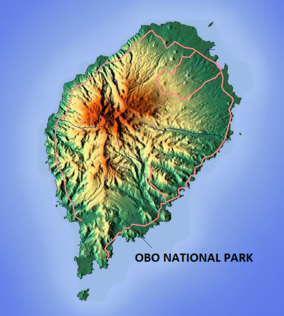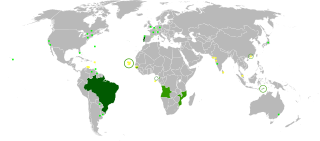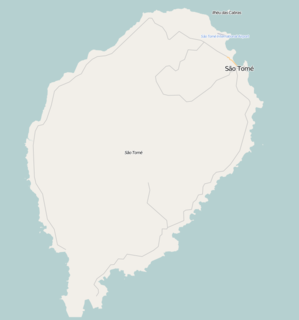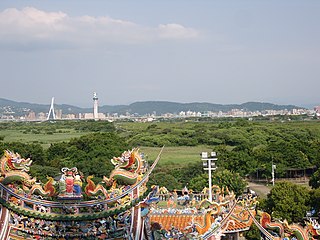
Príncipe is the smaller, northern major island of the country of São Tomé and Príncipe lying off the west coast of Africa in the Gulf of Guinea. It has an area of 136 square kilometres (53 sq mi) and a population of 7,324 (2012). The island is a heavily eroded volcano speculated to be over three million years old, surrounded by smaller islands including Ilheu Bom Bom, Ilhéu Caroço, Tinhosa Grande and Tinhosa Pequena. Part of the Cameroon Line archipelago, Príncipe rises in the south to 947 metres at Pico do Príncipe. The island is the main constituent of the Autonomous Region of Príncipe, established in 1995, and of the coterminous district of Pagué.

Caué is a district of São Tomé and Príncipe, on São Tomé Island. Covering 267 km2 (103 sq mi), it is the largest of the nation's seven districts in terms of area. In population it is the smallest, with 6,031 residents (2012). The district seat is São João dos Angolares. It is divided into the two statistical subdistricts São João dos Angolares and Malanza.

Lembá is a district of São Tomé and Príncipe, on São Tomé Island. Its area is 229.5 km2 (89 sq mi), and its population is 14,652 (2012). The district seat is Neves. It is divided into the two statistical subdistricts Neves and Santa Catarina.

Pico de São Tomé is the highest mountain in São Tomé and Príncipe at 2,024 m (6,640 ft) elevation. It lies just west of the centre of São Tomé Island, in the Parque Natural Obô de São Tomé and in the Lembá District. The second highest point, Pico de Ana Chaves, lies about 3 km to its south east. The town Santa Catarina is 8 km to the west.

The São Tomé shrew is a white-toothed shrew about 3.0 in (7.6 cm) long found only on São Tomé Island, São Tomé and Príncipe. It is listed as a critically endangered species due to habitat loss and a restricted range. It was discovered in 1886. The population continues to decrease, making these animals rare. It is found only on São Tomé Island, a small island that is actually a shield volcano that rises out of the Atlantic Ocean.
The São Tomé, Príncipe, and Annobón moist lowland forests is a tropical moist broadleaf forest ecoregion that covers the islands of São Tomé and Príncipe, which form the island nation of São Tomé and Príncipe, as well as the island of Annobón, which is part of Equatorial Guinea.
Hyperolius molleri is a species of frog in the family Hyperoliidae. It is endemic to São Tomé Island. Records from Príncipe now refer to Hyperolius drewesi, described as a distinct species in 2016.
Hyperolius thomensis is a species of frog in the family Hyperoliidae. It is endemic to the island of São Tomé in São Tomé and Príncipe. Common name Sao Tome giant treefrog has been coined for it. It is the largest Hyperolius species.
Ptychadena newtoni is a species of frog in the Ptychadenidae family. It is endemic to the island of São Tomé in São Tomé and Príncipe, where it occurs up to 600 metres elevation. Its natural habitats are swamps, freshwater marshes, arable land, plantations, rural gardens, urban areas, heavily degraded former forest, ponds, and canals and ditches. It is threatened by habitat loss. The animal was first described as Rana newtoni by Bocage in 1886. The species is named after Francisco Xavier Oakley de Aguiar Newton (1864–1909).

The São Tomé fiscal, or Newton's fiscal, is a species of bird in the family Laniidae. It is endemic to São Tomé Island, São Tomé and Príncipe. It is 20 to 21 centimeters long. The bird is black above with a white shoulder-scapular bar. The São Tomé fiscal has a pale yellow chin, breast, belly, flanks vent and under tail. Its graduated tail has all black central tail feathers and an increasing amount of white on outer web from inner to outer tail feathers. The Lanius newtoni has a clear voice with a whistle tiuh tiuh often repeated and metallic tsink tsink audible over a long distance.
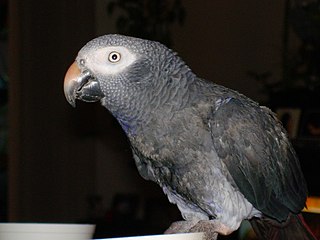
The wildlife of São Tomé and Príncipe is composed of its flora and fauna. São Tomé and Príncipe are oceanic islands which have always been separate from mainland West Africa and so there is a relatively low diversity of species, restricted to those that have managed to cross the sea to the islands. However the level of endemism is high with many species occurring nowhere else in the world.
The São Tomé free-tailed bat is a species of bat in the family Molossidae. It is endemic to São Tomé and Príncipe. Its natural habitats are dry savanna, moist savanna, and plantations. It is threatened by habitat loss. Only three individuals have ever been documented.
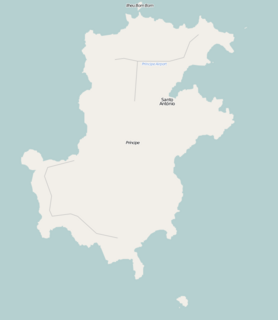
Pico do Príncipe is a mountain on the island of Príncipe, the smaller of the two inhabited islands of São Tomé and Príncipe. The elevation of the mountain is 947 metres (3,107 ft), making it the highest peak on the island. The island is one of the volcanic swells that make up the Cameroon line of extinct and active volcanoes.
Rio Xufexufe is a river in the island of São Tomé, São Tomé and Príncipe. The river flows southward through the southern part of the Lembá District and empties into the Atlantic Ocean 10 km northwest of Vila Malanza. Its catchment area is 16.5 km2 (6.4 sq mi). The endangered birds São Tomé olive pigeon and São Tomé fiscal have been observed in the catchment of the river.

Lagoa Azul is a small bay in the northern part of the island of São Tomé in São Tomé and Príncipe. It is part of the Parque Natural Obô de São Tomé. It is 4 km northwest of the town Guadalupe. It is a popular spot for diving. There is a lighthouse near the bay, built in 1997.
Tomensis is Latin for "of Thomas" or "of the island of São Tomé". It may refer to several species:
Thomensis is Latin for "of Thomas" or "of the island of São Tomé". It may refer to several species found on the island and in the surrounding waters:
Miniopterus newtoni is a species of bat that is endemic to São Tomé and Príncipe.
